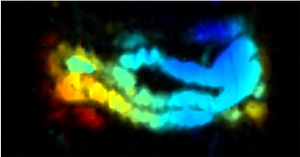Jul 25 2014
A multi-institutional team of researchers has developed a new nanoscale agent for imaging the gastrointestinal (GI) tract. This safe, noninvasive method for assessing the function and properties of the GI tract in real time could lead to better diagnosis and treatment of gut diseases.
 Applying a method that uses nanoparticles to create visual contrast, a researcher created the above photoacoustic image of a mouse intestine. The colors indicate the depth of the intestine (red: deep; blue: shallow). Photo: Jonathan Lovell
Applying a method that uses nanoparticles to create visual contrast, a researcher created the above photoacoustic image of a mouse intestine. The colors indicate the depth of the intestine (red: deep; blue: shallow). Photo: Jonathan Lovell
Illnesses such as small bowel bacterial overgrowth, irritable bowel syndrome and inflammatory bowel disease all occur in the intestine and can lead to serious side effects in patients with diseases such as diabetes and Parkinson’s.
Until now, there hasn’t been a good way to functionally image the intestine. However, in a paper published on July 6 in the journal Nature Nanotechnology, the researchers demonstrated that through a complementary approach using photoacoustic imaging and positron emission tomography (PET), they have created a multimodal functional imaging agent that could be used to perform noninvasive functional imaging of the intestine in real time.
Weibo Cai — an associate professor of radiology, medical physics and biomedical engineering at the University of Wisconsin-Madison — worked collaboratively with Jonathan Lovell, an assistant professor of biomedical engineering at the State University of New York at Buffalo, and Chulhong Kim, an assistant professor of creative information technology engineering at Pohang University of Science and Technology in South Korea. The team developed a family of nanoparticles that can provide good optical contrast for imaging — yet avoid absorption into the body and withstand the harsh conditions of the stomach and intestine.
Currently, patients drink a chalky liquid called barium and technicians view the intestine through X-rays and ultrasound. These methods, however, have many limitations, including accessibility and the possibility of radiation exposure.
The researchers' nanoparticles contain bright dyes. Patients still will drink a liquid, but it will contain the nanoparticles and allow an imaging technician to noninvasively view the illuminated intestine with photoacoustic imaging. “We can actually see the movement of the intestine in real time,” Lovell says.
Cai and Lovell worked collaboratively to use two imaging techniques. Cai specializes in PET imaging — which uses radioisotope-based tracers and is used in health care settings for noninvasive, whole-body imaging. Lovell and Kim’s expertise is in photoacoustic imaging, a technique that draws on ultrasound to generate high-definition images through light-based imaging.
While photoacoustic techniques yield high-definition images, PET imaging can penetrate deeper and image the entire body. Combining the two delivers the most information possible: high-definition images, images deep inside the body and a view of the intestine in relation to the entire body.
So far, the researchers have conducted successful test trials in mice and are hoping to move to human trials soon. “This is one of the first studies using both imaging techniques,” Cai says. “The two imaging techniques work well together and get us all of the information that we need.”
Both Lovell and Cai are excited about what the new imaging agent might mean for patients. “We could potentially induce a paradigm shift that allows for much more routine examination of the intestine function,” Lovell says. “That would really benefit overall health.”
Cai hopes the imaging agent can be targeted to look for certain disease-related markers and be used in therapeutic applications in the near future. “It is everything I would hope for in an imaging agent, and it is safe since we use FDA-approved agents to make these nanoparticles. That is why I am so excited about this,” he says. “These are the promising first steps.”
Grants from the National Institutes of Health, the Department of Defense and the Korean Ministry of Science funded the research. Additional authors on the paper include Yumiao Zhang, Mansik Jeon, Laurie J. Rich, Hao Hong, Jumin Geng, Yin Zhang, Sixiang Shi, Todd E. Barnhart, Paschalis Alexandridis, Jan D. Huizinga and Mukund Seshadri.